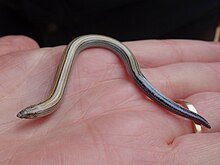| Typhlacontias brevipes | |
|---|---|

| |
|
Scientific classification
| |
| Domain: | Eukaryota |
| Kingdom: | Animalia |
| Phylum: | Chordata |
| Class: | Reptilia |
| Order: | Squamata |
| Family: | Scincidae |
| Genus: | Typhlacontias |
| Species: | T. brevipes
|
| Binomial name | |
| Typhlacontias brevipes
FitzSimons, 1938
| |
| Synonyms [2] | |
| |
Typhlacontias brevipes, also known as FitzSimon's [ sic] burrowing skink [3] or short blind dart skink, [2] is a species of skink endemic to the Namib Desert (Namibia). [2] [3] It was described by Vivian FitzSimons in 1938. [2]
The species name is derived from the Latin words brevis, -e = short and pes, pedis = foot. [2]
These slender skinks have small eyes with no eyelids and no external ear openings. [3] The hindlimb rudiments are visible on either side of cloaca. [2] The body coloration varies from light buff to sulphur yellow. Vague stripes, formed by the scales, can occur along the back and upper flanks. The tail is blue-grey. They can reach a snout–vent length of 113 mm (4.4 in). [3]
Females are viviparous and give birth to up to three young. [3]
Typhlacontias brevipes typically occur on the leeward side of dunes in the roots of grass tufts found in semi-stable sand. They are active at night and in the cooler hours of the day when they forage for small insects like ants, termites, antlions, and beetles. [3]
- ^ Bauer, A.M.; Becker, F. (2020). "Typhlacontias brevipes". IUCN Red List of Threatened Species. 2020: e.T44979509A44979514. doi: 10.2305/IUCN.UK.2020-3.RLTS.T44979509A44979514.en. Retrieved 18 November 2021.
- ^ a b c d e f Typhlacontias brevipes at the Reptarium.cz Reptile Database. Accessed 7 September 2020.
- ^ a b c d e f "FitzSimon's burrowing skink". Cardboard Box Travel Shop - Namibia. Retrieved 7 September 2020.
Photographs available at:
| Typhlacontias brevipes | |
|---|---|

| |
|
Scientific classification
| |
| Domain: | Eukaryota |
| Kingdom: | Animalia |
| Phylum: | Chordata |
| Class: | Reptilia |
| Order: | Squamata |
| Family: | Scincidae |
| Genus: | Typhlacontias |
| Species: | T. brevipes
|
| Binomial name | |
| Typhlacontias brevipes
FitzSimons, 1938
| |
| Synonyms [2] | |
| |
Typhlacontias brevipes, also known as FitzSimon's [ sic] burrowing skink [3] or short blind dart skink, [2] is a species of skink endemic to the Namib Desert (Namibia). [2] [3] It was described by Vivian FitzSimons in 1938. [2]
The species name is derived from the Latin words brevis, -e = short and pes, pedis = foot. [2]
These slender skinks have small eyes with no eyelids and no external ear openings. [3] The hindlimb rudiments are visible on either side of cloaca. [2] The body coloration varies from light buff to sulphur yellow. Vague stripes, formed by the scales, can occur along the back and upper flanks. The tail is blue-grey. They can reach a snout–vent length of 113 mm (4.4 in). [3]
Females are viviparous and give birth to up to three young. [3]
Typhlacontias brevipes typically occur on the leeward side of dunes in the roots of grass tufts found in semi-stable sand. They are active at night and in the cooler hours of the day when they forage for small insects like ants, termites, antlions, and beetles. [3]
- ^ Bauer, A.M.; Becker, F. (2020). "Typhlacontias brevipes". IUCN Red List of Threatened Species. 2020: e.T44979509A44979514. doi: 10.2305/IUCN.UK.2020-3.RLTS.T44979509A44979514.en. Retrieved 18 November 2021.
- ^ a b c d e f Typhlacontias brevipes at the Reptarium.cz Reptile Database. Accessed 7 September 2020.
- ^ a b c d e f "FitzSimon's burrowing skink". Cardboard Box Travel Shop - Namibia. Retrieved 7 September 2020.
Photographs available at:
